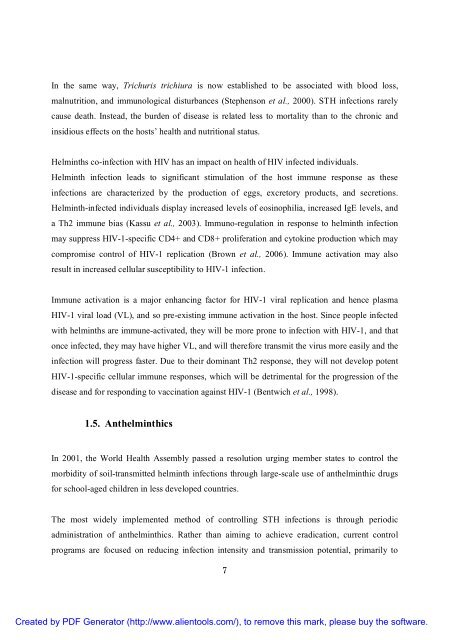Fikireselassie Samuel.pdf - Addis Ababa University
Fikireselassie Samuel.pdf - Addis Ababa University
Fikireselassie Samuel.pdf - Addis Ababa University
You also want an ePaper? Increase the reach of your titles
YUMPU automatically turns print PDFs into web optimized ePapers that Google loves.
In the same way, Trichuris trichiura is now established to be associated with blood loss,<br />
malnutrition, and immunological disturbances (Stephenson et al., 2000). STH infections rarely<br />
cause death. Instead, the burden of disease is related less to mortality than to the chronic and<br />
insidious effects on the hosts’ health and nutritional status.<br />
Helminths co-infection with HIV has an impact on health of HIV infected individuals.<br />
Helminth infection leads to significant stimulation of the host immune response as these<br />
infections are characterized by the production of eggs, excretory products, and secretions.<br />
Helminth-infected individuals display increased levels of eosinophilia, increased IgE levels, and<br />
a Th2 immune bias (Kassu et al., 2003). Immuno-regulation in response to helminth infection<br />
may suppress HIV-1-specific CD4+ and CD8+ proliferation and cytokine production which may<br />
compromise control of HIV-1 replication (Brown et al., 2006). Immune activation may also<br />
result in increased cellular susceptibility to HIV-1 infection.<br />
Immune activation is a major enhancing factor for HIV-1 viral replication and hence plasma<br />
HIV-1 viral load (VL), and so pre-existing immune activation in the host. Since people infected<br />
with helminths are immune-activated, they will be more prone to infection with HIV-1, and that<br />
once infected, they may have higher VL, and will therefore transmit the virus more easily and the<br />
infection will progress faster. Due to their dominant Th2 response, they will not develop potent<br />
HIV-1-specific cellular immune responses, which will be detrimental for the progression of the<br />
disease and for responding to vaccination against HIV-1 (Bentwich et al., 1998).<br />
1.5. Anthelminthics<br />
In 2001, the World Health Assembly passed a resolution urging member states to control the<br />
morbidity of soil-transmitted helminth infections through large-scale use of anthelminthic drugs<br />
for school-aged children in less developed countries.<br />
The most widely implemented method of controlling STH infections is through periodic<br />
administration of anthelminthics. Rather than aiming to achieve eradication, current control<br />
programs are focused on reducing infection intensity and transmission potential, primarily to<br />
7<br />
Created by PDF Generator (http://www.alientools.com/), to remove this mark, please buy the software.
















